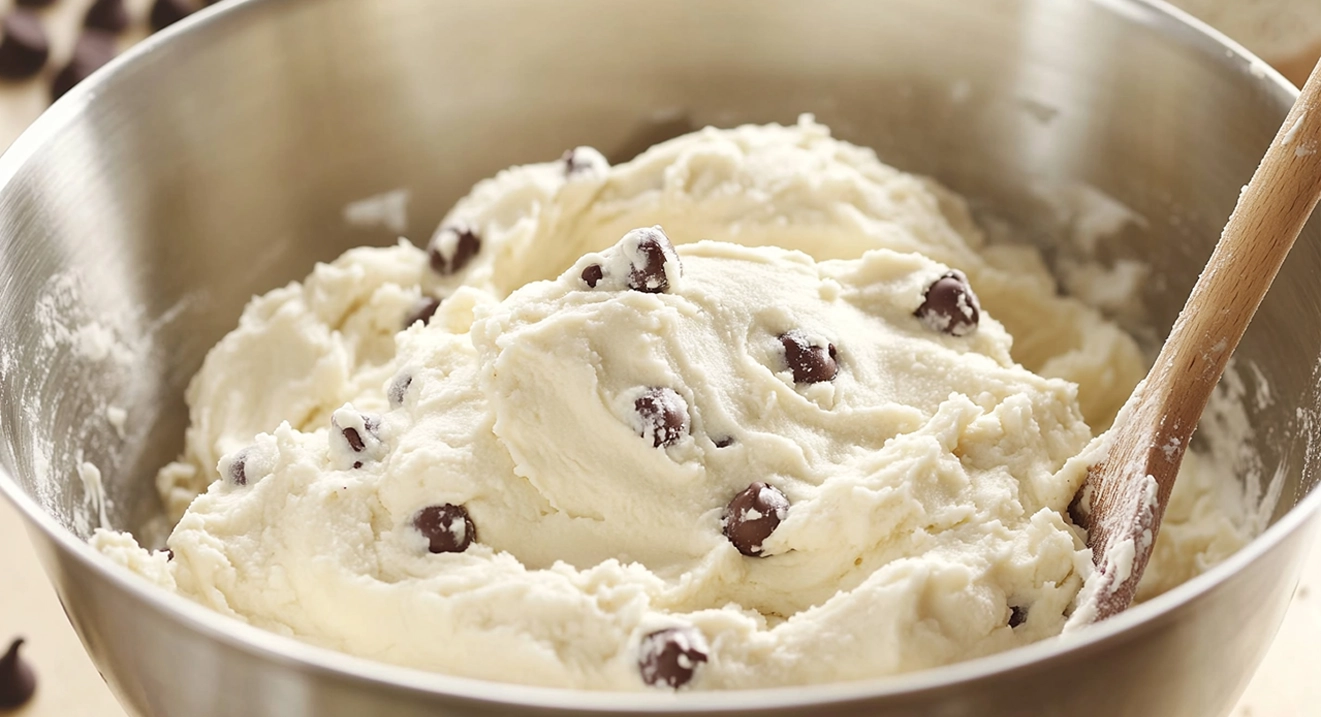
Table of Contents
Introduction to Cookie Dough
What is Cookie Dough?
Cookie dough recipe is a mixture of ingredients typically used to make cookies. The primary ingredients include flour, sugar, butter, eggs, and various flavorings or add-ins like chocolate chips, nuts, or dried fruits. The dough is prepared and then either baked into cookies or sometimes enjoyed raw, especially edible cookie dough, which is made safe to eat by removing eggs or heat-treating the flour.
Brief History of Cookie Dough
The origin of cookie dough can be traced back to the early 19th century when the modern cookie (or biscuit, as it’s known in some places) was invented in Europe. In the United States, cookie dough gained popularity when chocolate chip cookies were first created in the 1930s by Ruth Wakefield, who invented the iconic chocolate chip cookie dough recipe at her Toll House Inn. The combination of simple ingredients in cookie dough and the ease of preparation helped establish it as a beloved treat worldwide.
Popular Uses
Cookie dough has a variety of uses beyond making traditional cookies. Some of the most popular include:
- Classic Cookies: Cookie dough is most commonly used to bake cookies, especially chocolate chip cookies, oatmeal cookies, and sugar cookies.
- Edible Cookie Dough: Due to food safety concerns about consuming raw eggs, edible cookie dough has gained popularity as a safe-to-eat alternative. It is often used as a topping for ice cream or eaten straight from the spoon.
- Cookie Dough Ice Cream is a beloved dessert made with chunks of raw or baked cookie dough mixed into creamy ice cream.
- Cookie Dough Bars and Truffles: Cookie dough can be molded into bite-sized treats, chilled, and enjoyed without baking.
- Pie Crusts and Other Desserts: Cookie dough can also be used creatively in pies, tarts, and other baked goods, adding a rich and sweet flavor to the crust or filling.
Essential Ingredients for the Perfect Cookie Dough recipe
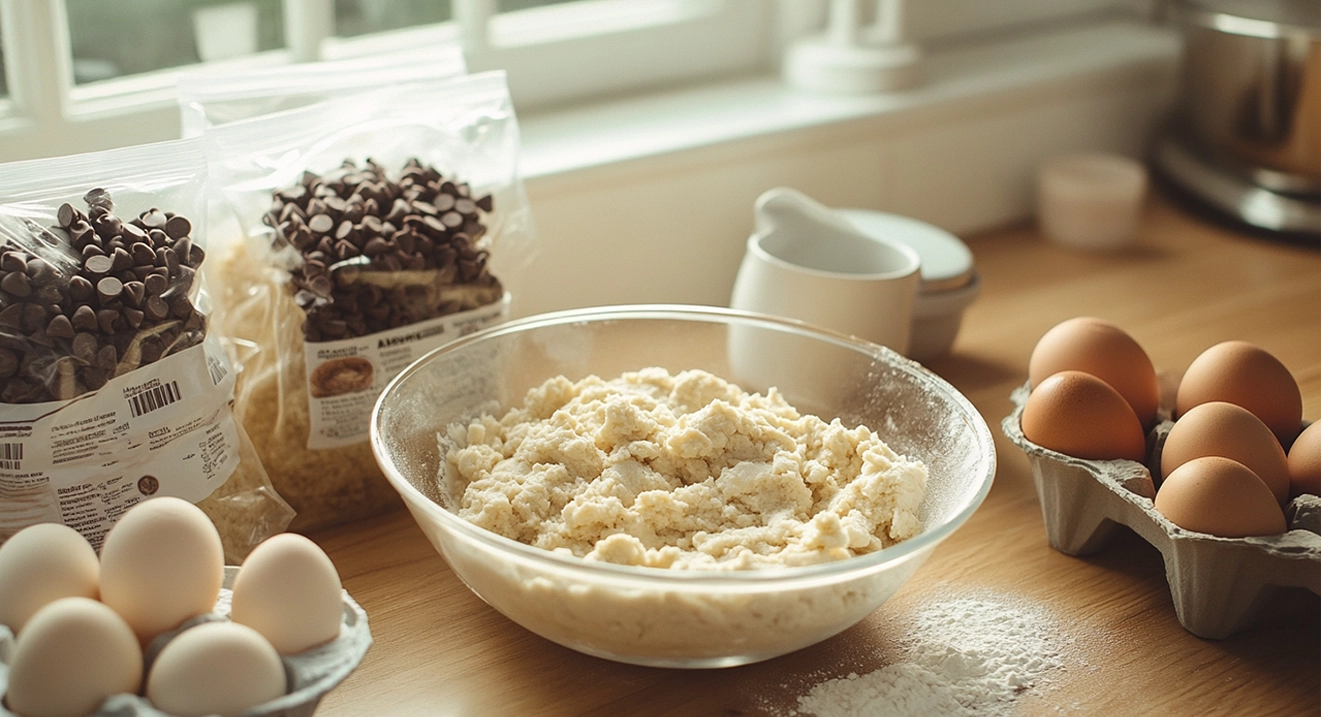
Core Ingredients Explained
You’ll need a few core ingredients to create the ideal texture and flavor to make the perfect cookie dough recipe . Here’s a breakdown of each:
- Flour is the primary structure-builder in cookie dough. All-purpose flour is most commonly used, providing the right amount of gluten to create chewy cookies. For a softer texture, you might opt for cake flour.
- Sugar: Two types of sugar are typically used in cookie dough: granulated sugar and brown sugar. Granulated sugar helps cookies spread, while brown sugar, due to its molasses content, adds moisture and a rich, caramel-like flavor.
- Butter: This fat helps create a tender, melt-in-your-mouth texture. Unsalted butter is preferred, as it gives you control over the amount of salt in the dough.
- Eggs: Eggs bind the ingredients together and add structure. They also contribute to the dough’s moisture and texture. A single egg is usually enough for most recipes.
- Baking Soda or Powder: These leavening agents help the dough rise slightly, making the cookies light and airy. Baking soda is most common and is often used with acidic ingredients like brown sugar or chocolate.
- Salt: A small amount of salt enhances the flavors in the dough and balances the sweetness.
- Add-ins: These include chocolate chips, nuts, dried fruits, or spices like cinnamon. The type and amount of add-ins often make a cookie recipe unique.
Choosing Quality Ingredients
For the best cookie dough, selecting high-quality ingredients is crucial. Here’s how to choose the best:
- Butter: Opt for high-quality, unsalted butter, as it directly impacts the flavor and texture of your dough. Grass-fed butter is often recommended for its richer flavor.
- Sugar: A mix of white and brown sugars is key to achieving the perfect balance between crispiness and chewiness. Ensure your brown sugar is fresh, as it can harden over time.
- Flour: Always use fresh, high-quality, all-purpose flour, contributing to the dough’s structure and consistency. Measure accurately to avoid altering the dough’s texture.
- Eggs: Choose fresh, large eggs from a trusted source. Free-range or organic eggs are often recommended for superior flavor.
- Vanilla Extract: For flavor, opt for pure vanilla extract over artificial vanilla, which can have a less complex taste.
Substitutions and Variations
If you’re looking to make changes to your cookie dough or have dietary restrictions, there are plenty of substitutions and variations you can experiment with:
- Flour Substitutes: For a gluten-free option, use a gluten-free or almond flour blend. For a more tender dough, experiment with cake flour instead of all-purpose flour.
- Butter Substitutes: If you need a dairy-free option, substitute butter with vegan butter or coconut oil. For a healthier fat alternative, try using avocado or applesauce.
- Sugar Substitutes: You can use coconut sugar, maple syrup, or honey instead of refined sugar. However, these may alter the texture and flavor slightly.
- Egg Substitutes: To make the dough egg-free, consider using a flax egg (1 tablespoon of ground flaxseed mixed with three tablespoons) or chia seeds mixed with water. Silken tofu or applesauce can also act as a binding agent.
- Flavor Variations: Experiment with different add-ins, such as swapping chocolate chips for white chocolate or peanut butter chips. Add cinnamon, nutmeg, or cardamom for a warm, aromatic touch. For a unique twist, you can also mix in shredded coconut, chopped dried fruits, or even pretzels.
Tools and Equipment You’ll Need
Must-Have Tools
To make cookie dough efficiently and achieve the best results, there are a few essential tools you’ll need:
- Mixing Bowls: A few large, sturdy mixing bowls are essential for combining ingredients. Stainless steel or glass bowls are ideal because they are durable and easy to clean.
- Hand or Stand Mixer: A stand mixer is great for large batches of dough, as it saves time and effort. A hand mixer works well for smaller batches, giving you the control to mix ingredients thoroughly.
- Measuring Cups and Spoons: Accurate measurements are key to successful cookie dough. Use dry measuring cups for flour and sugar and liquid measuring cups for wet ingredients like vanilla extract. Measuring spoons ensure precision for small ingredients like salt or baking soda.
- Spatula or Wooden Spoon: A spatula is necessary for scraping down the sides of the bowl to ensure all ingredients are incorporated. A sturdy wooden spoon helps mix dough, especially if you do it by hand.
- Baking Sheets: A flat, even baking surface is essential for baking cookies. Use heavy-duty baking sheets for best results, as they provide uniform heat distribution.
- Parchment Paper or Silicone Baking Mats: Lining your baking sheets with parchment paper or silicone mats ensures that cookies won’t stick, making clean-up easier and preventing uneven baking.
- Cookie Scoop: A cookie scoop ensures uniform cookie sizes, leading to even baking. It also saves time when portioning the dough onto baking sheets.
Optional Gadgets for Ease
While not necessary, these gadgets can make your cookie dough preparation more straightforward and more efficient:
- Dough Divider or Bench Scraper: If you’re making a large batch of dough, a dough divider can help you portion it evenly, while a bench scraper makes it easier to transfer dough onto baking sheets.
- Cookie Press: A cookie press allows you to quickly shape dough into decorative patterns or create uniform cookies. It’s beneficial for making pressed cookies or spritz cookies.
- Cooling Racks: After baking, a cooling rack helps cookies cool evenly, allowing air to circulate underneath them and preventing them from becoming soggy.
- Kitchen Timer: A timer helps you keep track of baking times to prevent overbaking and ensure that cookies come out perfectly golden brown.
- Silicone Spatula: A flexible silicone spatula is excellent for mixing sticky dough, as it can scrape up every last bit without damaging the bowl or dough.
Safety Tips for Handling Tools
When working with baking tools, safety should always be a priority. Here are a few tips to keep in mind:
- Sharp Tools: Some tools, like knives or pastry cutters, can be sharp. Always handle them carefully and significantly when cutting dough or transferring ingredients. Store them safely, out of the reach of children.
- Hot Surfaces: Baking sheets and pans can get very hot. To avoid burns, use oven mitts or pot holders to remove hot items from the oven. Be cautious when working around the stove, as the temperature inside can be extreme.
- Mixing Equipment: Be cautious with the beaters or paddle attachments if using an electric mixer. Always turn the mixer off before adding ingredients or scraping the sides of the bowl to avoid injuries.
- Storage of Tools: Keep all your baking tools in good condition by properly cleaning and storing them safely, especially sharp items like knives or cookie cutters. Always dry tools thoroughly before storing them to prevent rust.
Step-by-Step Instructions for Making Cookie Dough Recipe
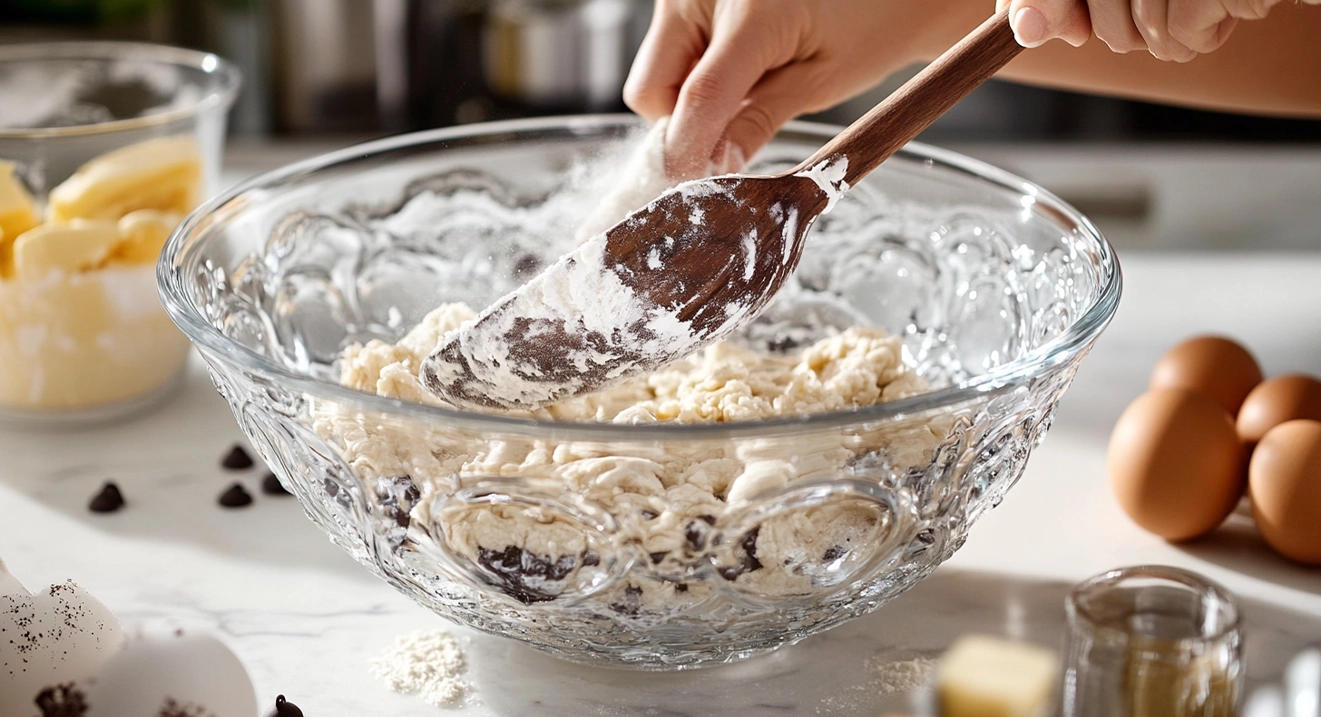
Preparation Tips
Before diving into the actual mixing and baking, proper preparation will set you up for success:
- Preheat the Oven: Always preheat your oven to the temperature specified in your recipe before mixing your dough. This ensures the cookies bake evenly when they hit the hot oven.
- Room Temperature Ingredients: Ensure your butter and eggs are at room temperature. Softened butter mixes better with the sugars, creating a smoother dough, while room-temperature eggs help incorporate all ingredients evenly.
- Measure Ingredients Carefully: Use the right tools to measure your ingredients accurately for the best results. Spoon the flour into the measuring cup and level it off with a knife to avoid packing too much flour into the cup.
- Line Your Baking Sheets: Prepare your baking sheets with parchment paper or silicone mats to prevent sticking and ensure even baking.
- Chill the Dough (Optional): Some recipes recommend chilling the dough for 30 minutes to an hour before baking to allow the flavors to meld and to prevent the cookies from spreading too much during baking.
Mixing Techniques
How you mix your ingredients plays a significant role in the final texture of your cookies. Here’s the right way to mix:
- Creaming Butter and Sugar: In a stand or hand mixer, beat the butter and sugar together on medium speed until light and fluffy, usually for 2–3 minutes. This process incorporates air into the mixture, which helps create a tender, chewy texture.
- Adding Eggs and Vanilla: Add the eggs one at a time, mixing well after each addition. Then, add the vanilla extract. Be sure to scrape down the sides of the bowl to ensure everything is evenly mixed.
- Incorporating Dry Ingredients: In a separate bowl, whisk together your dry ingredients (flour, baking soda, and salt). Gradually add the dry mixture to the wet ingredients, mixing on low speed or using a spatula. Stay undermixed at this stage, as this can result in tough cookies.
- Fold in Add-ins: Once the dough comes together, gently fold in your add-ins (chocolate chips, nuts, etc.) using a spatula or spoon. This helps evenly distribute the ingredients without overworking the dough.
Achieving the Ideal Consistency
The consistency of your cookie dough is key to ensuring that your cookies turn out just right. Here’s how to achieve the perfect dough consistency:
- Dough Should Be Thick: When scooped, cookie dough should be thick enough to hold its shape. If it’s too runny or soft, it may spread too much during baking. If your dough is too sticky, you can add a little more flour, a tablespoon at a time.
- Soft But Not Too Sticky: If the dough feels too sticky to handle, chill it in the fridge for about 30 minutes. Chilling helps solidify the fat and firm up the dough, making it easier to scoop.
- Dough Should Not Be Too Dry: On the flip side, if your dough is too dry or crumbly, it may need more moisture. In this case, add a teaspoon of milk or water to help bring it together.
- Scoopable Consistency: The dough should be firm enough to scoop with a cookie or spoon. It should hold its shape without running or sticking excessively to your hands or utensils.
Variations of Cookie Dough Recipe
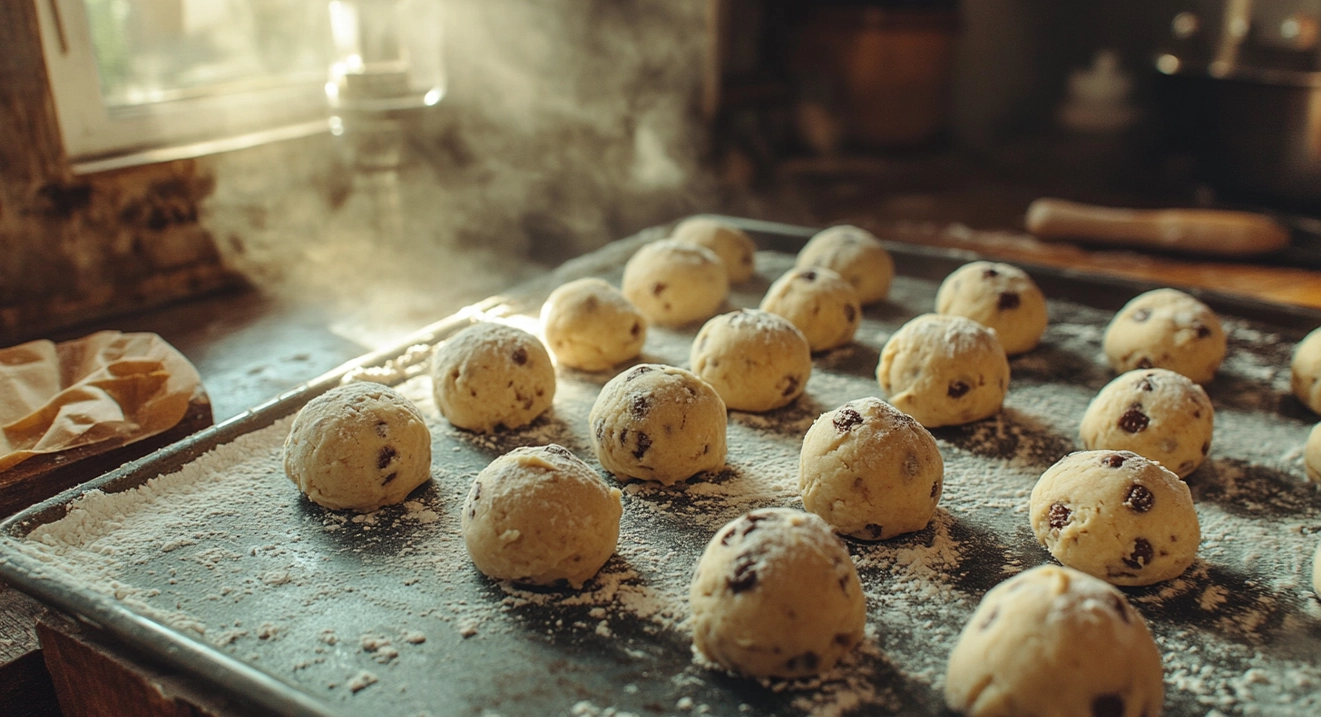
Edible Cookie Dough Recipe (No Eggs)
Edible cookie dough is a safe, delicious way to enjoy cookie dough without the risk of consuming raw eggs. This recipe omits eggs and uses heat-treated flour to ensure it’s safe to eat. Here’s how to make it:
Ingredients:
- 1 1/2 cups all-purpose flour (heat-treated*)
- 1/2 cup unsalted butter, softened
- 1/3 cup granulated sugar
- 1/3 cup packed brown sugar
- One teaspoon of vanilla extract
- Two tablespoons milk (or dairy-free milk)
- 1/4 teaspoon salt
- 1/2 cup chocolate chips (optional)
Instructions:
- Heat-Treat the Flour: Preheat your oven to 350°F (175°C). Spread the flour evenly on a baking sheet and bake for 5-7 minutes, stirring halfway through. This kills any potential bacteria in the raw flour.
- Cream Butter and Sugar: In a bowl, beat the softened butter, granulated sugar, and brown sugar until light and fluffy, about 2-3 minutes.
- Add Wet Ingredients: Mix in the vanilla extract and milk.
- Combine Dry Ingredients: Gradually stir in the heat-treated flour and salt until thoroughly combined.
- Add Chocolate Chips: If desired, fold in the chocolate chips (or any other add-ins you like).
- Serve: Enjoy immediately as a sweet snack or chill in the fridge for later.
*Note: To heat-treat flour, bake it in the oven as described or microwave it in a microwave-safe bowl in 30-second intervals, stirring between intervals.
Vegan and Gluten-Free Options
For those following a vegan or gluten-free diet, you can still enjoy cookie dough by making a few substitutions:
Vegan Cookie Dough
Ingredients:
- 1 1/2 cups all-purpose flour (or gluten-free flour blend)
- 1/2 cup coconut oil (or vegan butter), softened
- 1/3 cup coconut sugar (or any granulated sweetener)
- 1 teaspoon vanilla extract
- Two tablespoons almond milk (or other plant-based milk)
- 1/4 teaspoon salt
- 1/2 cup vegan chocolate chips
Instructions:
- Cream the Coconut Oil and Sugar: Beat the softened coconut oil and coconut sugar together until smooth and fluffy.
- Add Wet Ingredients: Stir in vanilla extract and almond milk until combined.
- Combine Dry Ingredients: Gradually add the flour and salt until smooth.
- Add Chocolate Chips: Gently fold in the vegan chocolate chips.
- Enjoy: Serve immediately or refrigerate for later.
Gluten-Free Cookie Dough
Ingredients:
- 1 1/2 cups gluten-free flour blend (ensure it includes xanthan gum)
- 1/2 cup unsalted butter (or dairy-free butter)
- 1/3 cup brown sugar
- One teaspoon of vanilla extract
- Two tablespoons milk (or dairy-free milk)
- 1/4 teaspoon salt
- 1/2 cup chocolate chips
Instructions:
- Cream Butter and Sugar: Beat the butter and brown sugar together until smooth.
- Add Wet Ingredients: Mix in the vanilla and milk until fully incorporated.
- Combine Dry Ingredients: Gradually add the gluten-free flour and salt, mixing until the dough comes together.
- Fold in Chocolate Chips: Add chocolate chips and mix gently.
- Chill and Serve: Chill for a firmer texture or serve immediately.
Flavor Add-Ons (e.g., Chocolate Chip, Peanut Butter)
Cookie dough can be customized in endless ways by adding different flavors or ingredients. Here are some popular add-ons to consider:
- Chocolate Chip Cookie Dough: The classic! Fold in 1/2 to 3/4 cup of semi-sweet or dark chocolate chips into the dough. You can also try milk chocolate or even white chocolate chips for variety.
- Peanut Butter Cookie Dough: Add 1/2 cup of peanut butter to the dough for a rich, nutty flavor. You can also fold in chopped peanuts for extra crunch or drizzle melted peanut butter on top for a decorative touch.
- Oatmeal Cookie Dough: Add 1 cup of rolled oats to your dough for a chewy twist. For extra flavor and texture, you can also fold in raisins, dried cranberries, or chopped nuts.
- Mint Chocolate Cookie Dough: Mix in 1/4 teaspoon of peppermint extract for a minty flavor and add chocolate chips or chunks for the perfect mint chocolate experience.
- M&Ms or Candy Pieces: Add colorful M&Ms or any of your favorite candy pieces for a fun, sweet cookie dough treat.
- Cinnamon Swirl Cookie Dough: Add one teaspoon of cinnamon to your dough and swirl it with a few teaspoons of brown sugar for a warm, spiced flavor.
Frequently Asked Questions (FAQs)
What makes cookie dough?
Cookie dough is made from essential ingredients such as flour, butter, sugar, eggs, and baking soda or powder. These ingredients work together to form a dough that can be baked into cookies. The flour provides structure, the butter adds flavor and texture, the sugar sweetens, the eggs bind everything together, and the leavening agent helps the dough rise during baking. Additional flavorings or add-ins like chocolate chips, nuts, or vanilla extract are often added to enhance the taste.
What are the seven steps in making cookies?
- Preheat the Oven: Always preheat your oven to the temperature specified in the recipe before starting.
- Prepare Baking Sheets: Line your baking sheets with parchment paper or silicone mats for easy removal and even baking.
- Cream Butter and Sugar: Beat the butter and sugar together until light and fluffy, which helps create a tender texture in the cookies.
- Add Wet Ingredients: Mix eggs and vanilla extract into the butter-sugar mixture until fully incorporated.
- Combine Dry Ingredients: In a separate bowl, whisk together flour, baking soda or powder, and salt, then gradually add the dry mixture to the wet ingredients.
- Fold in Add-ins: Stir in chocolate chips, nuts, or any other add-ins by hand using a spatula, ensuring they are evenly distributed.
- Scoop and Bake: Scoop the dough onto prepared baking sheets and bake in the preheated oven for the time specified in the recipe.
Can I make cookie dough by hand?
Yes, you can make cookie dough by hand! While using a stand or hand mixer can save time and effort, mixing cookie dough by hand is possible. Use a spatula or a wooden spoon to cream the butter and sugar together, then add the wet ingredients, followed by the dry ingredients. This method may require more elbow grease but will give you complete control over the dough’s consistency. Be careful to work the dough evenly, as uneven work can lead to tough cookies.
What is the standard method for preparing cookie dough recipe?
The most common method for preparing cookie dough is the creaming method. This involves beating softened butter and sugar together until light and fluffy. This process helps incorporate air into the dough, giving the cookies a light, tender texture. Once the butter and sugar are well-cleaned, the eggs and vanilla are added, followed by the dry ingredients (flour, baking soda, and salt). Finally, add-ins, such as chocolate chips or nuts, are gently folded. The dough is then scooped onto baking sheets and baked in the oven. This popular method results in the classic cookie texture most people love.
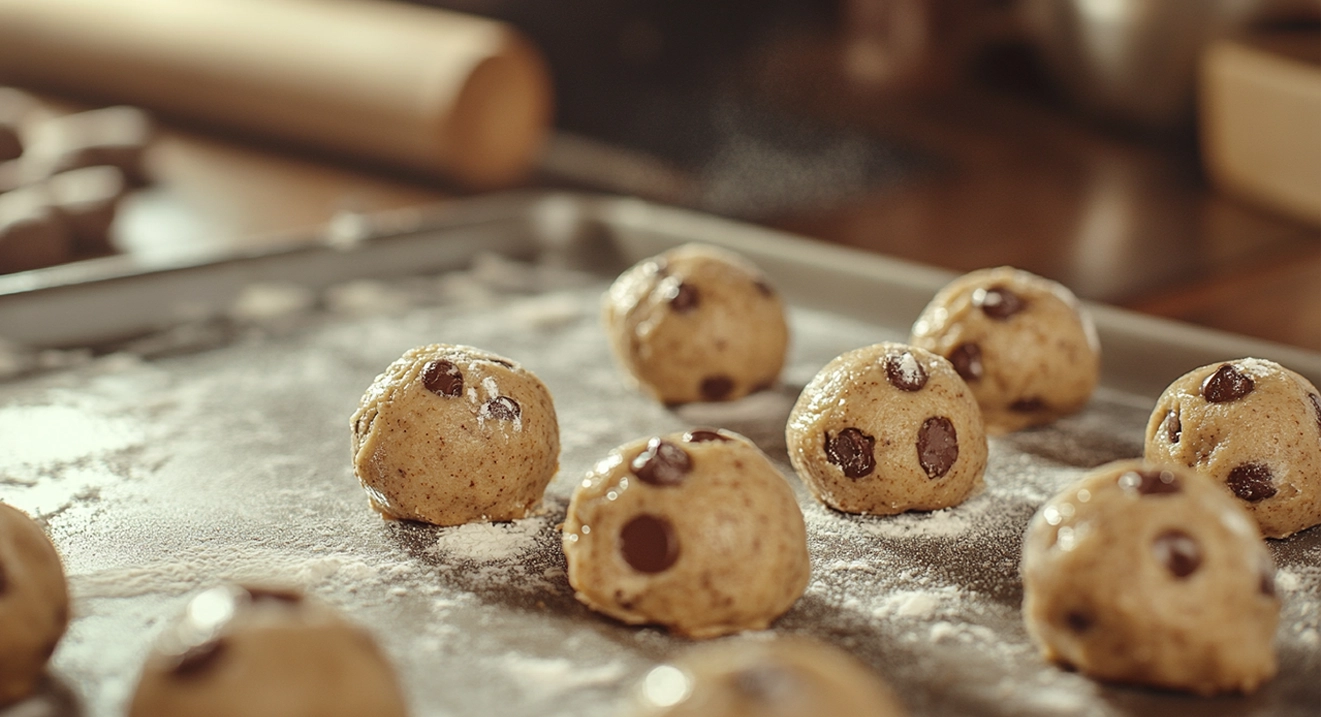
Conclusion
Making cookie dough recipe is a straightforward yet rewarding process. By understanding the core ingredients, such as flour, butter, sugar, eggs, and baking soda, you can easily create the perfect dough for various cookies. Mixing techniques, like creaming butter and sugar together, and ensuring the dough is the right consistency are crucial for achieving the best texture. There are endless ways to customize your dough, from making it egg-free for edible cookie dough to creating vegan or gluten-free versions. Flavor add-ins like chocolate chips, peanut butter, or cinnamon allow you to experiment and create unique variations.
